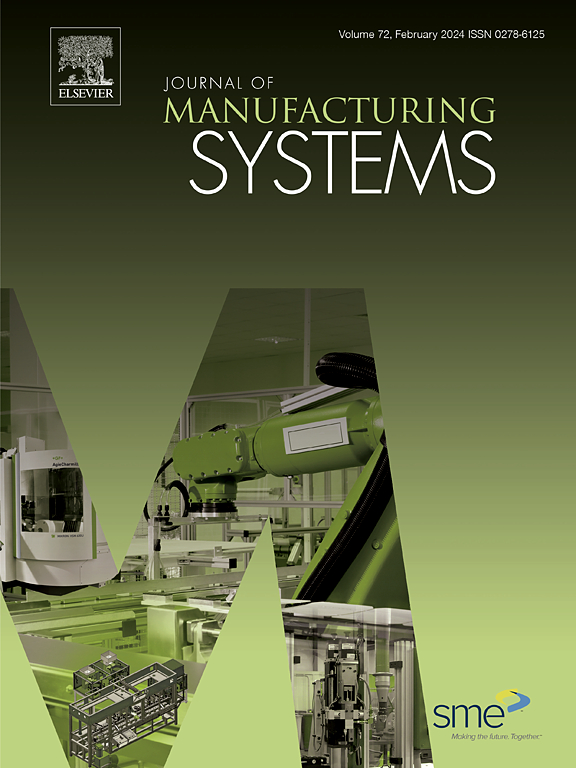设计工人辅助系统-方法开发和工业验证
IF 12.2
1区 工程技术
Q1 ENGINEERING, INDUSTRIAL
引用次数: 0
摘要
本研究报告提出了一种设计和实施工人援助系统的综合方法,重点是提高工业环境中的技术接受度。进行了系统的文献回顾,以分析现有的方法,识别差距,并定义方法的需求。提出的方法TERA-AS(任务、环境、相关性、辅助系统的接受)首先对初始工作环境进行详细分析,使用结构化问卷和指南捕获物理压力、任务复杂性和工作特定条件。然后导出必要辅助功能的目录,并将这些需求与16种不同的辅助系统相匹配,从而便于根据成本效益分析选择最优解决方案。TERA-AS强调员工参与系统设计,并在整个实施过程中进行清晰的沟通,以促进技术接受。因此,这一办法不仅注重建立技术和经济上可行的援助职能,而且确保技术被接受。它应用于现实世界的工业用例,特别是在控制柜制造中。测试系统是基于人工智能生成的位置数据的激光投影光学辅助系统。对该系统的评估显示,尽管涉及未经培训的人员,该系统在手工装配过程中节省了大量的时间,在布线方面节省了69.05 %,在电气装配方面节省了26.04 %。运营商的反馈强调了系统的有效性和需要改进的地方,例如材料供应和用户界面设计。总的来说,TERA-AS为数字化工人援助系统的实施提供了一个结构化的方法,通过早期的员工参与和持续的系统改进确保成功采用。本文章由计算机程序翻译,如有差异,请以英文原文为准。
Designing worker assistance systems–Methodology development and industrial validation
This research paper presents a comprehensive methodology for the design and implementation of worker assistance systems, with a focus on enhancing technology acceptance in industrial settings. A systematic literature review was conducted to analyze existing approaches, identify gaps, and define requirements for the methodology. The proposed methodology TERA-AS (Tasks, Environment, Relevance, Acceptance of Assistance Systems) begins with a detailed analysis of the initial working environment, capturing physical strain, task complexity, and job-specific conditions using a structured questionnaire and guidelines. A catalog of necessary assistance functions is then derived, and a system matrix matches these needs to 16 different assistance systems, facilitating the selection of an optimal solution based on a cost-benefit analysis. TERA-AS emphasizes employee involvement in system design and clear communication throughout the implementation process to foster technology acceptance. Therefore, this approach not only focuses on creating technologically and economically viable assistance functions, but also ensures technology acceptance. It was applied in a real-world industrial use case, specifically in control cabinet manufacturing. The tested system was a laser projection optical assistance system based on AI-generated positional data. Evaluation of the system showed significant time savings for manual assembly processes —approximately 69.05 % in wiring and 26.04 % in electrical assembly—despite involving untrained personnel. Feedback from operators highlighted both the system's effectiveness and areas for improvement, such as material provision and user interface design. Overall, TERA-AS provides a structured methodology to digital worker assistance system implementation, ensuring successful adoption through early employee engagement and continuous system improvement.
求助全文
通过发布文献求助,成功后即可免费获取论文全文。
去求助
来源期刊

Journal of Manufacturing Systems
工程技术-工程:工业
CiteScore
23.30
自引率
13.20%
发文量
216
审稿时长
25 days
期刊介绍:
The Journal of Manufacturing Systems is dedicated to showcasing cutting-edge fundamental and applied research in manufacturing at the systems level. Encompassing products, equipment, people, information, control, and support functions, manufacturing systems play a pivotal role in the economical and competitive development, production, delivery, and total lifecycle of products, meeting market and societal needs.
With a commitment to publishing archival scholarly literature, the journal strives to advance the state of the art in manufacturing systems and foster innovation in crafting efficient, robust, and sustainable manufacturing systems. The focus extends from equipment-level considerations to the broader scope of the extended enterprise. The Journal welcomes research addressing challenges across various scales, including nano, micro, and macro-scale manufacturing, and spanning diverse sectors such as aerospace, automotive, energy, and medical device manufacturing.
 求助内容:
求助内容: 应助结果提醒方式:
应助结果提醒方式:


